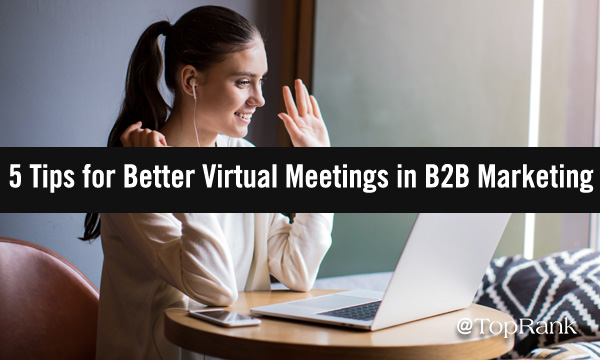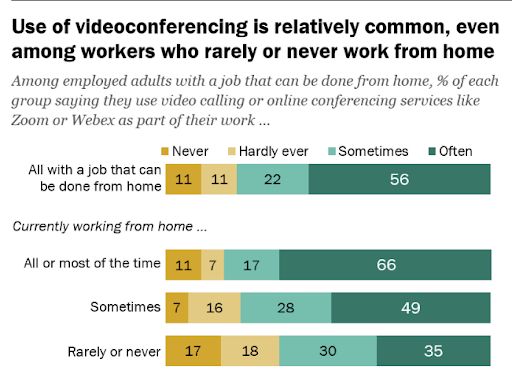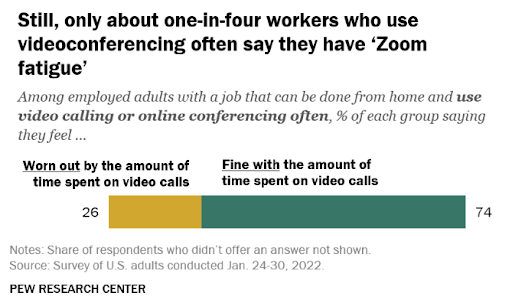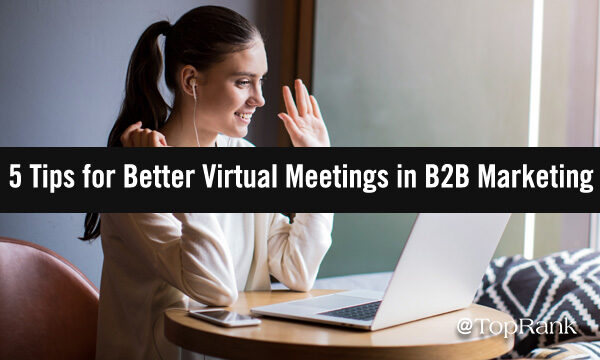
When the pandemic broke out in 2020 and forced most marketers into remote work, there was a big looming concern you’d often hear about: Zoom fatigue.
In a profession where meetings are frequent and essential, the danger of video-call burnout seemed to be acutely high. Would the endless reminders of our isolation and disconnection become too much to bear?
As it turns out, these concerns were somewhat overstated. Recent Pew Research found that usage of videoconferencing tools is very common, as expected …

(Source)
… But the percentage of professionals who report experiencing the dreaded “Zoom fatigue” is much lower than than the zoomsayers forecasted, with three in four saying they are fine with the amount of time they spend on video calls.

(Source)
That’s good to see, and I think it speaks to something I wrote about here a few weeks ago: the resilience and adaptability of human beings. We make the best: embrace the good, and find ways to mitigate the bad.
Of course, a marketer’s aspiration is not just to adapt, but to keep innovating and pushing the envelope while doing so. Achieving greater collaboration, productivity, and – most simply – enjoyment out of virtual meetings can make a big difference in the success of a team.
With this in mind, here are some tips to conduct better virtual meetings and keep Zoom fatigue from creeping in.
Keep Perspective on What Video Calls Make Possible
This is how you can “embrace the good.” Yes, for most of us, there is a diminishing factor to communicating with someone through a screen, rather than in person. However, the format also enables us to connect in real-time with anyone, anywhere on the planet.
“Embrace the good! Virtual meetings have downsides, but enable us to connect in real-time with anyone, anywhere on the planet. #ZoomFatigue #B2Bmarketing.” — Nick Nelson @NickNelsonMN Click To TweetSometimes, when I’m growing a bit weary on days crowded by video calls, I find it helpful to remind myself of the major advantages that come along with the downsides. I can have a face-to-face chat with teammates all around the country – from Portland to San Diego to Denver and beyond – at any moment. In fact, these technologies make it practical to have teammates (and clients) from all around the world to begin with!
Take Yourself Off the Screen
Researchers from the University of South Florida found that staring at yourself on-screen can be one of the biggest contributors to Zoom fatigue. It only makes sense. When able to see ourselves, we have a natural tendency to keep an eye on what we’re projecting to others. But this leads to an unnatural level of fixation, which can be distracting and cause us to be overly self-conscious.
The study found this impact to be more pronounced for women, who are consequently more likely than men to report experiencing Zoom fatigue.
No matter who you are, it’s wise to consider removing your feed from the video call so you can fully focus on the other people there instead of yourself, as you would during an in-person meeting.
In Fact, Consider Turning Off the Display Entirely at Times
Further studies have shown that videoconferencing has a negative impact on creativity and idea generation, which can be especially problematic for marketers. Researchers concluded that this issue comes down to focus and attention. Specifically, we’re directing too much to the faces on the screen.
“In the virtual condition people are looking significantly more at their partner – almost double – at the expense of their broader environment,” said Melanie Brucks, an assistant marketing professor at Columbia University. “I always suggest turning off the camera during idea generation, so you can walk around, you can look around.”
“I always suggest turning off the camera during idea generation, so you can walk around, you can look around.” — @MelanieBrucks #VirtualMeetings #B2Bmarketing Click To TweetIf you’ve noticed that your ideation process isn’t as strong through a video call, you might give this a try. Keep the sound on so you can still interact, but turn off your camera as well as the feeds of other participants, so your mind can roam free without any concern for how you or anyone is showing up on the screen.
Take Advantage of Features in Videoconferencing Tools
Platforms like Zoom, Microsoft Teams and Webex often have slick little features and functionalities that are underutilized. In many cases they can make your meetings far more interesting and engaging.
Capabilities you might consider using include:
- Live chat: Invite people to join the conversation in inventive ways, like using emojis to express their reactions.
- Changing the background: Get creative! Set a theme for your next meeting or hold contests to see who can show up with the best one. If you’re giving a presentation, your background could complement it visually.
- Polls: These are an easy way to make your meeting more interactive for participants.
Additionally, make ample use of screen-sharing! Don’t just pull up static spreadsheets; take meeting attendees through an experience along with you, or give an in-depth illustration of how to do something.
“Platforms like @Zoom @MicrosoftTeams and @Webex have many features and functionalities that are underutilized. Try using live chat, backgrounds, polls, and screen-sharing in inventive ways. #VirtualMeetings #B2Bmarketing.” — Nick Nelsom… Click To TweetMaster the Art of Conversing Virtually
Just like conversing in-person, there are tricks and techniques to become a more effective communicator through a screen. Fundamentals of exemplary virtual body language include a confident posture, looking into the camera to simulate eye contact, and using hand gestures.
Adapt and Thrive
As hackneyed as it’s become to call something “the new normal,” that term really does seem to apply to video calls in the business world. They were already fairly common and now they’ve become standardized as the de facto method of meeting.
By putting their adaptive and innovative instincts to good use, B2B marketers can maximize the benefits and minimize the detriments. And we can keep winning the battle against Zoom fatigue.



